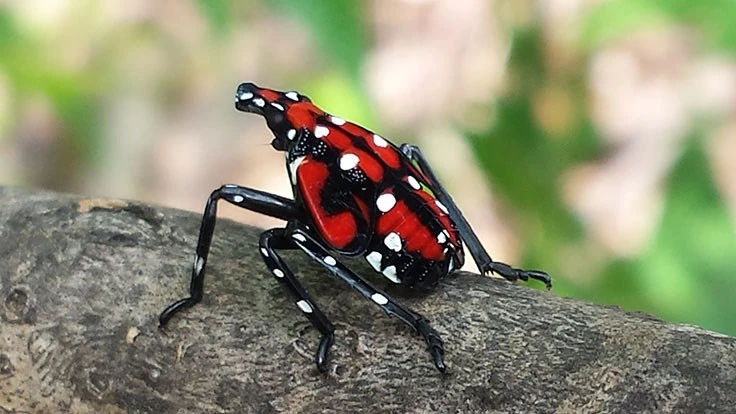
The U.S. Department of Agriculture announced earlier this month that it is awarding $17.5 million in emergency funding to halt the spread of the invasive spotted lanternfly.
The pest, first identified in Berks County in 2014, has spread throughout southeastern Pennsylvania into New Jersey, Delaware and Maryland. The spotted lanternfly is a major threat to agricultural and nursery crops, particularly fruit trees and hardwoods.
“We’ve seen a dramatic expansion in the range of this pest over the last year and we need to take decisive action to prevent the spotted lanternfly from spreading throughout Pennsylvania and into neighboring states,” USDA Secretary Sonny Perdue said. “We have the tools to fight this invasive insect and — together with the Pennsylvania Department of Agriculture — we have developed an area-wide approach that will begin before the pest starts to re-emerge in the spring.”
The spotted lanternfly, with its distinctive and colorful wings, was first identified in Pennsylvania in 2014.
The invasive insect threatens to destroy $18 billion worth of agricultural commodities produced in the state, such as apples, grapes and hardwoods, which would be devastating for producers and businesses. Further, if the state cannot contain or eradicate the pest, it could jeopardize exports of products to other states and countries that want to prevent the pest from establishing a presence.
The emergency funding, which was made available through existing Commodity Credit Corporation balances, will be used for a two-pronged approach to contain the threat. USDA's Animal and Plant Health Inspection Service will monitor and control the outside of the infestation area to stop the insect from spreading while the Pennsylvania Department of Agriculture will work within the core infestation area to reduce lanternfly populations.
In addition to emergency activities in Pennsylvania, APHIS is planning to use existing resources to conduct surveys, and control measures if necessary, in Delaware, Maryland, New Jersey, New York and Virginia, where there is growing concern about the potential spread of the insect.
In addition to the federal funding, Pennsylvania governor Tom Wolf proposed nearly $1.6 million in dedicated funding to combat the spotted lanternfly as part of his fiscal year 2018-19 budget plan.
“For more than three years, we have been trying to contain — if not eradicate — the spotted lanternfly in Pennsylvania,” said state agriculture secretary Russell Redding. “When it first appeared in Berks County, it was the first time this particular species had been found in North America. And while we have limited its spread, it’s clear we need dedicated resources to mount an effective response plan. Governor Wolf understands the importance of agriculture to Pennsylvania’s economy, which is why he proposed this funding and is making it a priority.”
Governor Wolf’s budget proposes $1.597 million in new funding through the Department of Agriculture’s General Government Operations appropriation. This funding will allow the department to step up efforts for detection and eradication of the pest; coordinate multi-agency response, outreach and training; and purchase and distribute supplies to other partners. The proposed funding will also be used to leverage additional support from the federal government.
For more about the spotted lanternfly, click here.
Photo courtesy Pennsylvania Department of Agriculture
Latest from Nursery Management
- GIE Media Horticulture Group wins five regional 2025 Azbee Awards of Excellence
- Get to know Pat Reilly with NewGen Boxwood and the American Boxwood Society
- Terra Nova Nurseries introduces rust-free and disease-resistant heucherella
- John T. Nickel, founder of Greenleaf Nursery Co., passes away at 89
- Three tours offered at 2025 Farwest Show
- Garden Media Group announces sixth annual Women in Horticulture Week
- Star Roses and Plants announces National Knock Out Rose Day
- The Growth Industry Episode 4: How federal budget cuts are affecting horticulture nonprofits





